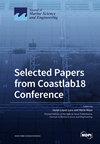用于浮动风力涡轮机网络物理测试的缆索驱动机器人的性能
IF 2.8
3区 地球科学
Q1 ENGINEERING, MARINE
引用次数: 0
摘要
网络物理测试已在流体力学实验室应用了十年,用于评估浮动风力涡轮机(FWT)在真实风浪条件下的动态性能。气动载荷由数值模拟器根据模型试验测量结果计算得出,并通过执行器实时施加到物理模型上。本文提出了一套简短而有针对性的基准测试,旨在量化网络物理 FWT 测试中使用的执行器的性能。这些测试旨在确保对所有相关频率的负载进行良好的跟踪,并对大运动进行令人满意的干扰抑制,从而提供逼真的测试设置。这些基准测试在 SINTEF Ocean 使用电缆驱动机器人测试的两个完全不同的 15 兆瓦全功率变流器模型上进行了示范。本文章由计算机程序翻译,如有差异,请以英文原文为准。
Performance of a Cable-Driven Robot Used for Cyber–Physical Testing of Floating Wind Turbines
Cyber–physical testing has been applied for a decade in hydrodynamic laboratories to assess the dynamic performance of floating wind turbines (FWTs) in realistic wind and wave conditions. Aerodynamic loads, computed by a numerical simulator fed with model test measurements, are applied in real time on the physical model using actuators. The present paper proposes a set of short and targeted benchmark tests that aim to quantify the performance of actuators used in cyber–physical FWT testing. They aim at ensuring good load tracking over all frequencies of interest and satisfactory disturbance rejection for large motions to provide a realistic test setup. These benchmark tests are exemplified on two radically different 15 MW FWT models tested at SINTEF Ocean using a cable-driven robot.
求助全文
通过发布文献求助,成功后即可免费获取论文全文。
去求助
来源期刊

Journal of Marine Science and Engineering
Engineering-Ocean Engineering
CiteScore
4.40
自引率
20.70%
发文量
1640
审稿时长
18.09 days
期刊介绍:
Journal of Marine Science and Engineering (JMSE; ISSN 2077-1312) is an international, peer-reviewed open access journal which provides an advanced forum for studies related to marine science and engineering. It publishes reviews, research papers and communications. Our aim is to encourage scientists to publish their experimental and theoretical results in as much detail as possible. There is no restriction on the length of the papers. The full experimental details must be provided so that the results can be reproduced. Electronic files and software regarding the full details of the calculation or experimental procedure, if unable to be published in a normal way, can be deposited as supplementary electronic material.
 求助内容:
求助内容: 应助结果提醒方式:
应助结果提醒方式:


